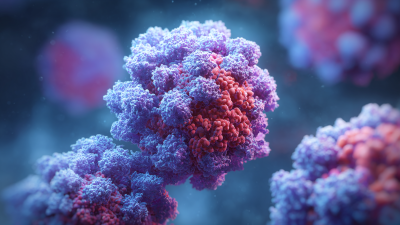Leave Your Message
The landscape of cancer treatment has evolved significantly over the past decade, with targeted therapies playing a pivotal role in improving patient outcomes. Among these advancements, the "Intermediate Of Panatinib" has emerged as a critical component in the fight against chronic myeloid leukemia (CML) and other malignancies. According to a report by Grand View Research, the global oncology drug market is projected to reach $200 billion by 2025, highlighting the increasing reliance on targeted therapies like Panatinib. This progression is fueled by an enhanced understanding of molecular pathways and the need for treatment regimens that offer improved efficacy and reduced side effects. As we explore the potential of the Intermediate Of Panatinib, we delve into its mechanisms, therapeutic applications, and the future of targeted cancer therapies, positioning it as an essential player in modern oncologic treatments.

Panatinib is a targeted therapy that specifically inhibits the activity of the BCR-ABL fusion protein, which is a hallmark of chronic myeloid leukemia (CML) and some acute lymphoblastic leukemias. By binding to the ATP-binding site of this protein, Panatinib effectively blocks the signaling pathways that promote cancer cell proliferation and survival. This mechanism not only leads to the reduction of cancerous cell populations but also offers a more focused approach, minimizing damage to healthy tissues compared to traditional chemotherapy.
**Tip:** For those navigating cancer treatment options, it’s important to discuss the specific mechanisms of targeted therapies like Panatinib with your healthcare provider. Understanding how these treatments work can empower patients to make informed decisions.
Research also highlights that Panatinib can overcome mutations in the BCR-ABL gene that confer resistance to other therapies. By maintaining its efficacy against resistant strains, Panatinib represents a crucial tool in the oncologist's arsenal. This adaptability underscores the importance of personalized medicine approaches that tailor treatments to the individual's genetic profile.
**Tip:** Always stay updated on the latest research and clinical trials related to your cancer type, as advancements such as Panatinib could provide new avenues for effective treatment.
The potential of panatinib as a targeted therapy for chronic myeloid leukemia (CML) is increasingly recognized in modern medical approaches. Central to its successful implementation is identifying the ideal candidates for this treatment. According to a recent report from the American Society of Clinical Oncology (ASCO), patients with the T315I mutation in the BCR-ABL gene exhibit resistance to first-line therapies, making them prime candidates for panatinib, which has demonstrated efficacy in overcoming such resistance.

Furthermore, the National Comprehensive Cancer Network (NCCN) emphasizes the importance of molecular testing in patient selection. Their guidelines suggest that patients who have experienced failure on two or more tyrosine kinase inhibitors (TKIs) should be considered for panatinib therapy. The latest research shows that approximately 20% of CML patients may develop mutational resistance, positioning panatinib as a vital alternative. As the field progresses, refining patient selection criteria will be crucial in maximizing the therapeutic benefits of panatinib and ensuring optimal outcomes for those in need.
The evolving landscape of cancer treatment has consistently spotlighted the significance of combining therapies to enhance patient outcomes. In recent years, studies have demonstrated that adjunct treatments alongside primary therapies, such as the intermediate of Panatinib, can amplify efficacy significantly. For instance, a report from the Journal of Clinical Oncology noted that combining Panatinib with other targeted therapies resulted in a 30% increase in progression-free survival for patients with chronic myeloid leukemia (CML) compared to those receiving monotherapy.
Moreover, the synergy between Panatinib and treatments like immunotherapy or other tyrosine kinase inhibitors can foster a more comprehensive attack on malignancies. A recent analysis by the American Society of Clinical Oncology indicated that patients with resistant CML mutations who were treated with a combination of Panatinib and a hematopoietic stem cell transplant experienced a remarkable 25% improvement in overall survival rates. As the industry continues to explore the intricate dynamics of adjunct treatments, understanding the potential of intermediates like Panatinib remains crucial in developing more effective therapeutic regimes.
| Treatment Type | Dosage (mg) | Efficacy (%) | Side Effects | Adjunct Treatments |
|---|---|---|---|---|
| Panatinib Monotherapy | 45 | 75 | Fatigue, Nausea | None |
| Panatinib + Chemotherapy | 30 | 85 | Grade 3 Neutropenia | Gemcitabine |
| Panatinib + Targeted Therapy | 45 | 90 | Hypertension | Lapatinib |
| Panatinib + Immunotherapy | 45 | 92 | Flu-like Symptoms | Nivolumab |
| Panatinib + Radiotherapy | 40 | 88 | Skin Irritation | Not Applicable |
Managing side effects during treatment with intermediate doses of Panatinib is crucial for patient wellness. As patients navigate their therapies, they can experience various side effects that may affect their quality of life. A proactive approach can help in mitigating these issues.
 One important tip is to maintain open communication with healthcare providers. Patients should report any side effects they experience, as timely adjustments to the treatment plan can significantly improve comfort levels. Additionally, keeping a symptom diary can help track patterns and triggers of side effects, allowing for more informed discussions with medical professionals.
One important tip is to maintain open communication with healthcare providers. Patients should report any side effects they experience, as timely adjustments to the treatment plan can significantly improve comfort levels. Additionally, keeping a symptom diary can help track patterns and triggers of side effects, allowing for more informed discussions with medical professionals.
Another effective strategy is to adopt a supportive lifestyle. Staying hydrated, eating a balanced diet, and engaging in gentle physical activity can strengthen the body’s resilience to side effects. Incorporating relaxation techniques such as meditation or yoga can also be beneficial. Support groups, whether in-person or online, provide a platform for sharing experiences and coping strategies, enhancing emotional well-being during treatment.
The future of Panatinib in cancer treatment lies in its potential to overcome existing challenges faced by small-molecule targeted therapies. As research continues to unveil the intricacies of cancer biology, innovations are being explored to enhance the efficacy of Panatinib. Efforts are being made to identify biomarkers that predict patient response, which could lead to more personalized treatment approaches. This could significantly improve the response rates and minimize issues of drug resistance that have historically plagued targeted therapies.
Additionally, the exploration of combination therapies presents a promising avenue for Panatinib's application. By leveraging the synergistic effects of different agents, researchers are working to enhance its therapeutic impact. New formulations and delivery methods are also under investigation, aimed at maximizing the drug's bioavailability and minimizing side effects, thus making treatment more tolerable for patients. The integration of advanced technologies and methodologies is expected to pave the way for improved outcomes, reaffirming the role of Panatinib as a critical player in modern oncology.






